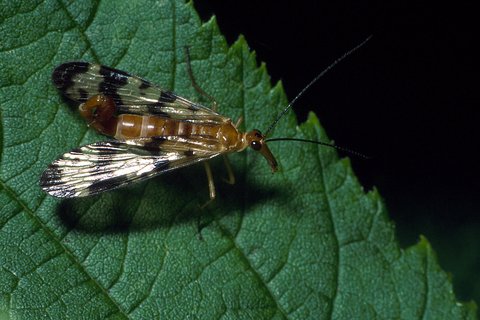Appearance
Scorpionflies (Panorpa spp.) are moderate-sized insects, about 3/8 inch long. They are typically yellowish brown with black bands or spots on four long wings. They have a long looking face because of a prolong beak; their chewing mouthparts are located at the end of this beak. The tip of the abdomen (actually the genitalia) of males is bulbous and held over their back, giving them the appearance of a scorpion.
Where and when do you find them
Common scorpionflies are found in deciduous forests and forest edges where they are found on the leaves of low-lying shrubs and herbaceous plants. They feed primarily on dead insects, although they have been known to steal insects from spider webs. They are most common during June and July.
What is their life cycle?
They often have complex mating rituals where the males offer females food, usually dead insects, or secrete spittle to entice them to mate. Males lacking such a gift may try to forcefully mate with females.
Females lay eggs in soil, rotting wood, or moss where the larvae live. Larvae take about a month to mature. Eventually they pupate in the soil. There is typically one generation a year.
Importance to Minnesotans
Despite their appearance to scorpions, they do not sting and are harmless to people. They are a wary insect, giving nature lovers a challenge to get close when collecting or photographing.
Fun Fact
It has been discovered recently that scorpionflies can play a role in forensic entomology, i.e. using insects to help determine how long a body has been dead or whether it has been moved. Research in Texas found that some insects, like the common scorpionfly, that are not normally found on dead bodies can interact with corpses and can provide important information to the forensic entomologist.
For more information
Four Forensic Entomology Case Studies: Records and Behavioral Observations on Seldom Reported Cadaver Fauna With Notes on Relevant Previous Occurrences and Ecology. Lindgren et al. Journal of Medical Entomology, 2015
Author and photo credit
Jeff Hahn




